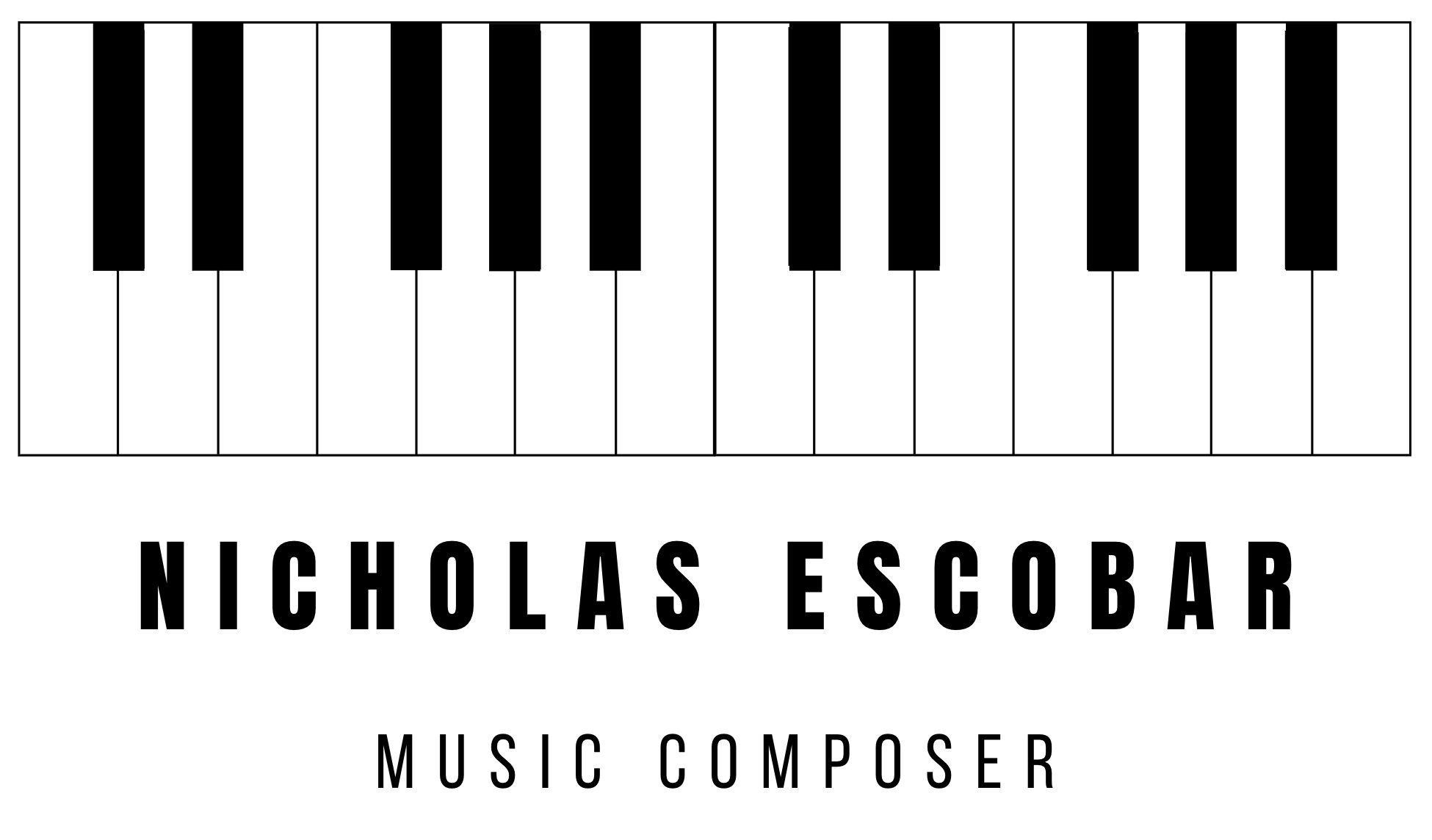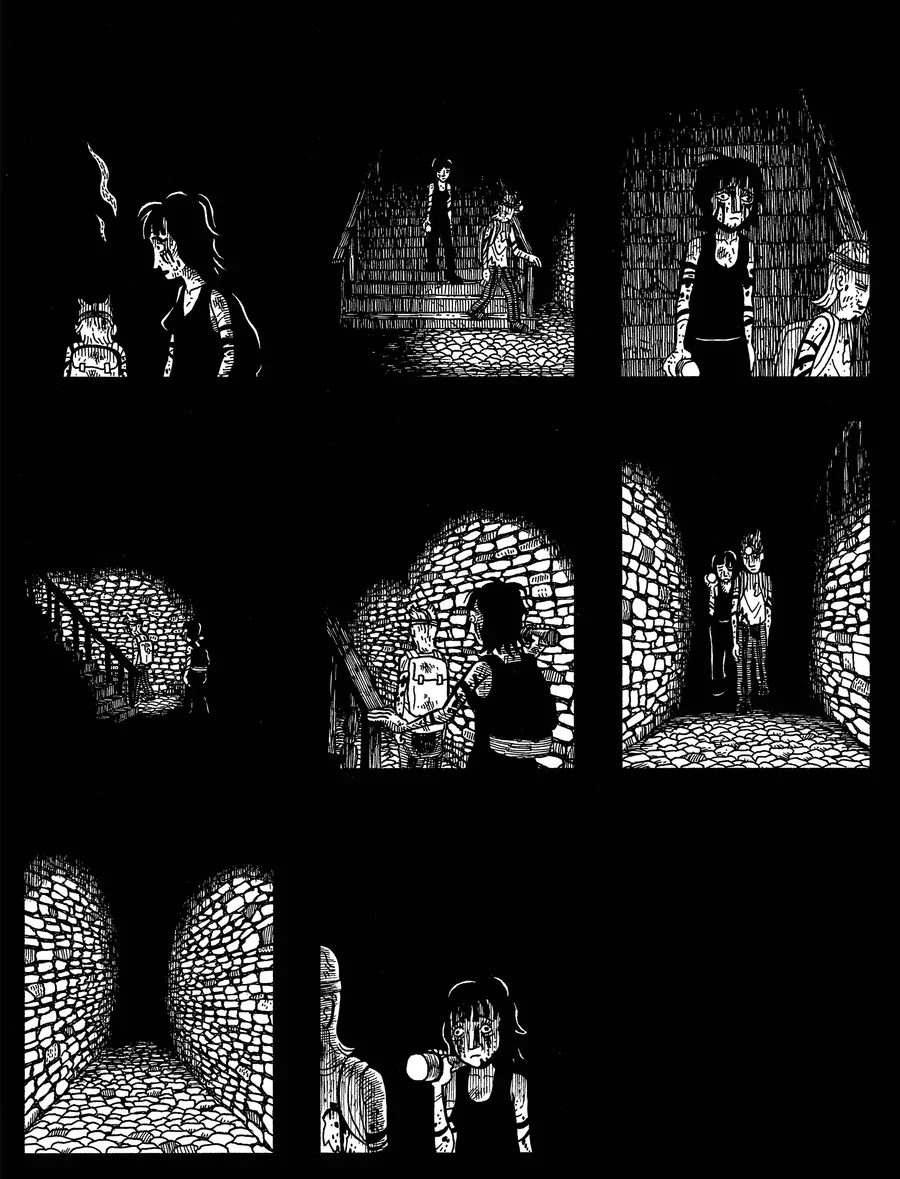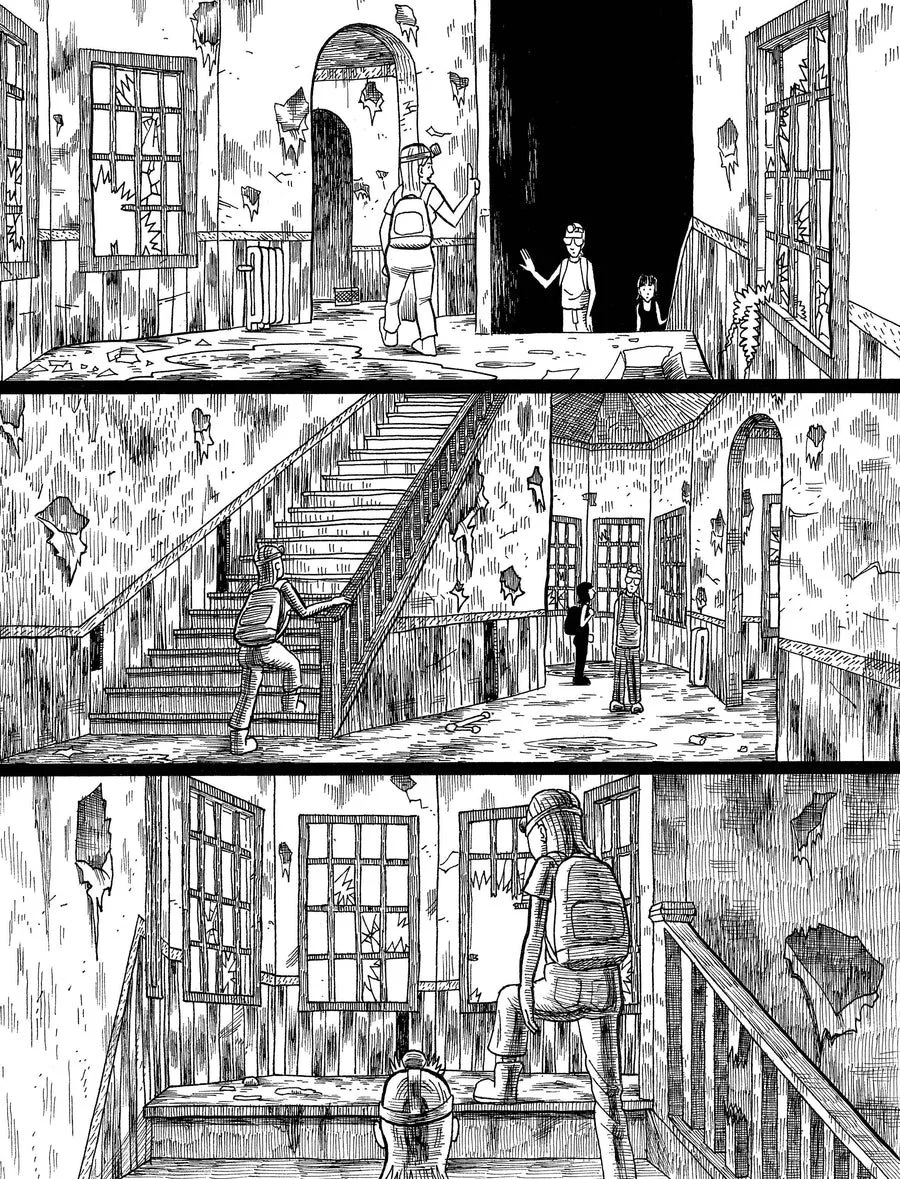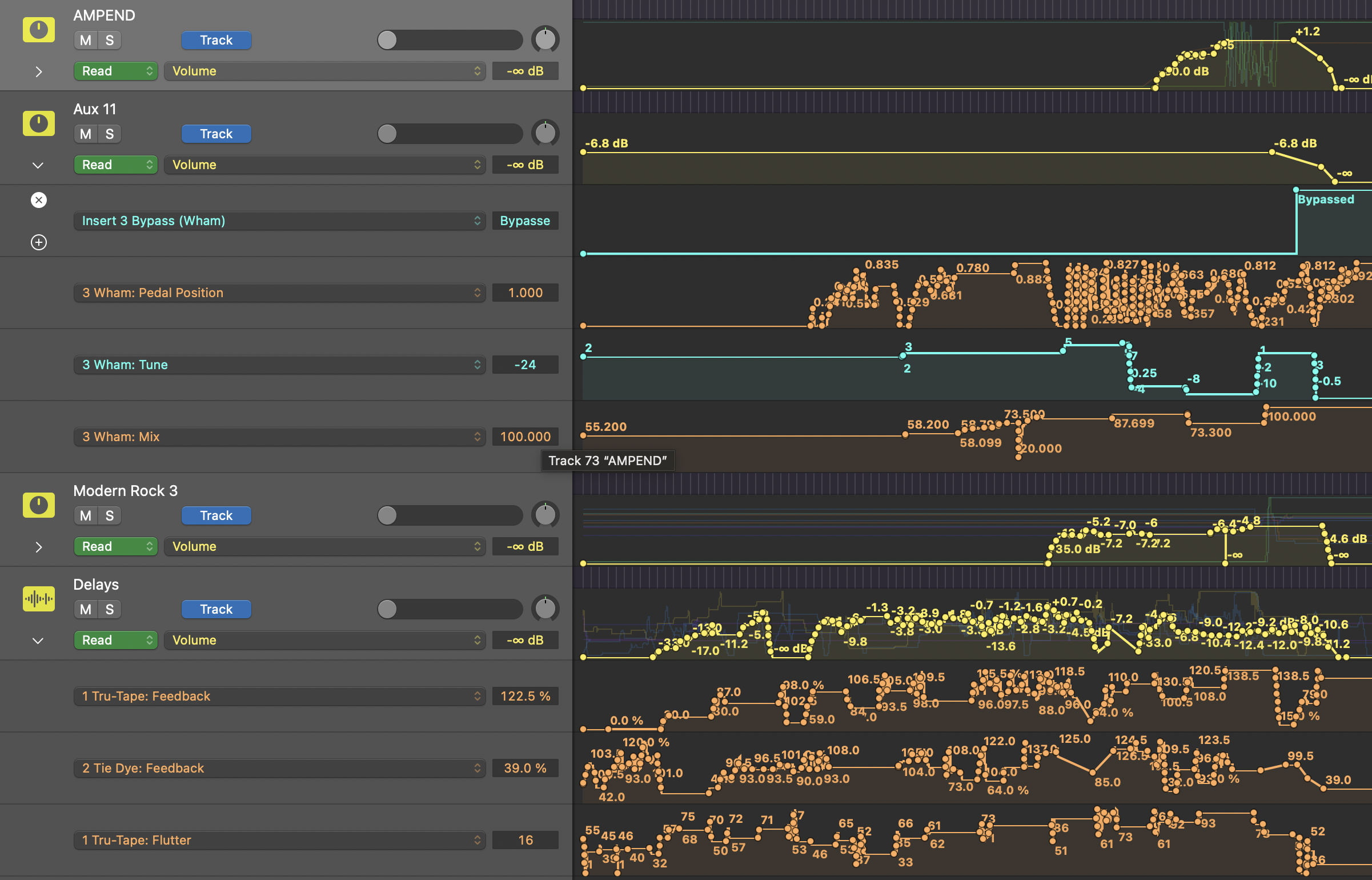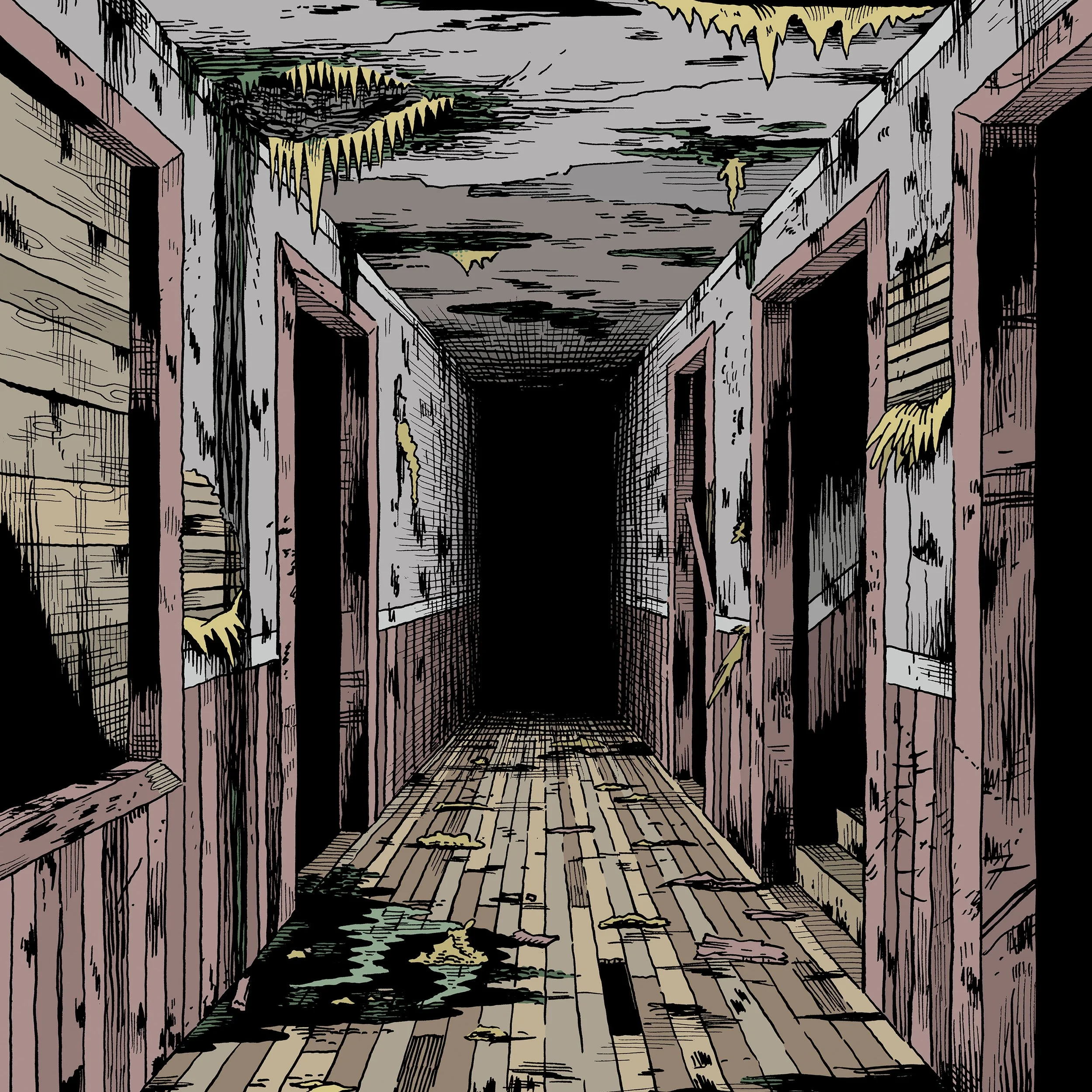My Composing Process: House (2025)
Dear Readers,
In late July 2024, I was in Skylight Books in Los Feliz, Los Angeles browsing the graphic novels. This has become a past time of mine since arriving to LA in March 2024 and I have amassed quite an eclectic collection. On that particular day, I came across the graphic novel “House” by Josh Simmons. The cover was arresting: a decrepit hallway. It felt visceral, eerie and surreal. I picked it up and read it cover to cover. It didn’t have any dialogue and instead communicated the terrifying tale entirely through visuals. The graphic novel medium at it’s very essence.
I immediately thought to myself: “this would be fun to compose music for”. So I reached out to Josh the next day via email and pitched the project. He agreed and we had a phone call to discuss his vision for the graphic novel and his musical influences. These are some of the excerpts from my notes from that call:
[Josh] drew “House” while listening to the band “Suicide” - minimalist electronic band
intense/harsh/simple
it is a minimal book. About a feeling. A tone. Simple trajectory (light to dark)
Nick Cave, Dirty Three - simple — manic
kind of pretty folk, synth, percussion half, atonal and noisy at the end
underwater scene (more surreal fantastical) - sunset (next turn) - portrait (next turn) - stair collapse
Cartooning boiling down to the essence
Ambient - gradually - a wave
metal and noise
So I listened to some of the musical references,. Suicide’s self titled first album from 1977 was quite a listen. It was discordant, at times disturbing, and very momentum-heavy.
With all this mental preparation, I was ready to begin.
Crafting the Melodies
On August 13, 2024, I sat down with my mini banjo and started improvising the theme that would become the main theme for “House”. You can hear my first recording of the demo below:
This theme (the “Idyllic” or “Pastoral” motif) came to represent the above-ground world. It has a wonderful folk quality to it. Centered around G major, it creates these lovely dissonant moments (like with the major 7th note F#) but eventually resolves to the G chord almost with a sense of relief. This melody also starts on the four chord (in this case C major) which in itself makes the melody feel without a center. You can see the notated melody below:
The idyllic, pastoral theme
A few weeks later I recorded a short demo of this theme on my Godin acoustic electric guitar. This demo helped set the course for the entire score.
Once I performed this demo, the beginning of the score and the end of the score seemed more in focus. I knew that the Idyllic melody would bookend the track. It would be played in a folk manner at the very beginning and then return at the end this time sounding distorted, slowed down and dissonant. In the final track, you actual hear this early demo mixed in, run through an amplifier and screeching away.
The House has a number of musical motifs. I treated the location as a character. The primary theme is played by an ominous and morphing synthesizer. You hear this melody as soon as they enter the house at the beginning:
I love this theme because it carries a sense of incoming dread. It is simple and yet terrifying. Part of this stems from the incomplete nature of the melody. It is supposedly in C minor, and yet both phrases end of notes note that aren’t in the C minor chord (F and D). This gives the theme a feeling of foreboding.
The second motif pertaining to the House is the “Adventure theme”. It is a repetitive melody that is essentially an arpeggio of C minor (with an added 4th at the end) and of F minor (with an added 2nd and 4th at the end). It is played as the characters enter the House and returns later, far more mangled.
The “Adventure” Motif
The third House motif is a rhythmic one. I wanted to create a non-melodic motif that could represent the utter terror of the House and the depths of its chaos. So I created an object sound rhythm using a number of metal recordings that I have done. These included: 1) a charcoal grill lid being dropped 2) a metal wind vane being hit and also scraped across the floor 3) a metal chain being shaken and 4) paper being moved back and forth quickly. You can see how I arranged the individual audio files to craft the rhythm:
And you can hear this rhythm in its entirety without FX (i.e. distortion) below:
I then ran this through a lot of distortion and that became the rhythm for the House. It appears early on, even as the idyllic pastoral theme is being played on the guitar. It materializes out of nothing just like the house does, and carries a sense of fear and danger.
The fourth House motif comes into play after the characters have descended down into the depths. It is a chaotic ostinato that is centered around C but utilizes a minor 7th (Bb) the sixth (A) and the 2nd (D). It is purposefully not in time and frequently doesn’t land on the down beat, adding to the offkilter nature of it. I created a slowed down version o this theme that plays as the chaos progresses, using the C - C - Bb - A - D note combo.
You can listen to early demos of the score by clicking this link.
The “House” Orchestra
Where do I start? There is a lot going on here. will briefly go through some of the highlights.
The synth that plays the main house theme is the Gentle Whalesong from Spitfire LABS. I ran it through grit distortion to get that intensity. This synth was one of my keys to crafting the score. The trio of synths that play the Adventure theme include a Rock bass (with rotor cabinet, grit and reverb), Uillean Pipes from Spitfire LABS and The Lightkeeper from Spitfire LABS. This combo of elements really helped me on the way to making the sound world of the piece. The Metallique Cries from Spitfire LABS Onda Musicales created a lovely texture near the end of the piece (undulating waves of sound).
For the percussion, the main elements were the House rhythm, drum kit toms and cymbals run through loads of FX (like distortion and echo and pitch shift), The Metal Drum Palm virtual instrument from Logic was run through an amp and echo to create an eerie percussive element in the later half of the piece. A shaker was used as well, also run through an amp.
I contrast these synth sounds with a selection of acoustic instruments. My Godin acoustic electric guitar plays at the beginning. For this I used both a stereo recording of the guitar and the input pickup recording. The piece begins with just the pickup sound and then the wider stereo sound of the natural guitar resonance blends with it and eventually overpowers it with automated reverb. My mini banjo also plays at the beginning. Piano appears during the underwater/sunrise sequence (playing the idyllic theme).
Soundscape-wise, you can hear crickets in Ohio, Vermont, Maine and Maryland. They all combine together to create a wonderful woods sound world. To create the frequently present low bassy sound, I ran one of the woods sound recordings through a ton of FX (like distortion, vibrato, pitch shift, an amp, clip distortion, reverb). This works well with the theme of the graphic novel because they descend underground, hence the above world sound being pitched very low.
As a part of the soundscape textures, I slowed down and/or reversed earlier parts of the score and had those edited tracks appear later in the score when everything is in disarray. For example, you can hear the “Adventure Theme” from the beginning slowed down, pitched down and run through a rotor cabinet. You can also hear the guitar recording from the beginning reversed and run through an amp and a rotor cabinet. The House Rhythm is also slowed down and pitched down at the end of the piece. I like the idea of earlier bitsof the score returning later but in a distorted and mangled way. This worked especially well for this graphic novel’s narrative. To further create this feeling, I manually slowed down the entire score near the end as everything falls apart.
You can check out my entire Logic session below:
,My entire Logic session for the 11.5 minute long “House” score.
Experimental Mixing
I did something new and different work-flow-wise for this piece. Because I wanted to have a sense of live improvisation to the score, I decided to cue up some delay and Wham pedals in Logic and do live automation performance, adjusting knobs in a randomized, chaotic way. I also had the entire score run through a number of amps and cued those up to appear later in the score. All these automations and FX were run through their own BUS so I was able to bounce out the entire FX track and then do even more volume edits during the mix. The result is an organic score that feels almost like a live performance. You can see in the image below how erratic some of the automations are.
I also got this score professionally mastered by Gabe Wolf and he did a fabulous job. This marks the first time that I’ve had one of my scores professionally mastered.
You can see the automations for the delay pedals and the amps. Automations are adjustments made in a Digital Audio Workspace that stay printed into the track.
How Does One Score A Graphic Novel?
This is the overarching thesis of this project, and a question that I have been pondering from the first moment that I laid eyes on “House” last year. When I tell people I’m scoring a graphic novel, their initial thought (rightly so) is that it is for a video of the graphic novel or for an experience online. I have to clarify that, no, it is for the physical book. My goal, from the very moment that I pitched this idea to Josh, was to have people press the play button and then start reading. The music would underscore their live experience reading the physical book.
Of course, everyone’s reading speeds are different. Josh and I both timed ourselves reading the book and we pinpointed possible time codes for certain major moments in the book. As I began scoring, the length of the score became longer, though I think the extra time allows for slower reading / contemplation / discovery. The key early on was to have the big moments mapped out and this would create the overall arc for the music. So we have the folk opening, the entrance to the house, the water scene + the sunrise, back into the house, discovering the small door, the stairs collapsing, the group breaking up, and then the subsequent terrible things that happen to each character. The music follows this arc, while also allowing for transitions between each of these moments so as not to feel too abrupt if a reader is reading slower or faster. The overall goal in the end was to create a sound world for the graphic novel to exist in, and for the readers to essentially score the graphic novel as they read. Each person will have certain moments in the score line up with different panels in the graphic novel, and that is super exciting. The music will exist outside of a timed space and be adaptable to every reader. It also allows for each individual reading of the graphic novel to be different.
Ever since arriving out here to LA in March 2024, I’ve become more and more fascinated with the world of graphic novels and zines. Unique art styles automatically capture my musical imagination. I think there is an entirely untapped space for composing unique scores for graphic novels and to further enhance the reading experience. My score for Josh Simmons’s “House” is an example of this.
Conclusions
Thanks so Josh for replying to my email last year and agreeing to this collaboration. Also I just want to acknowledge again how cool his work is, I highly recommend checking it out if you haven’t already. Thanks to Gabe for mastering the score and bringing it to life even more. This was an awesome scoring experience all around. I was able to push myself musically, entering into an entirely new genre I haven’t really explored before. I also experimented extensively with how to score an experience that is different for each individual that encounters it. Unlike video game music, this music doesn’t loop and can’t be triggered to chance at certain moments. This is just one track that can exist across multiple different reading speeds with a physical book.
I can’t wait to hear back from readers on how they experience with ‘House’ is with this original score.
Your’s Musically,
Nicholas Escobar
Some comic/graphic novel store recommendation in LA:
Secret Headquarters in Atwater Village
Skylight Books in Los Feliz
Heavy Manners Library in Echo Park
Counterpoint Records and Books in Franklin Village
Golden Apple Comics on Melrose
Some graphic novel recommendations:
Swimming In Darkness by Lucas Harari
Jessica Farm by Josh Simmons
Tongues by Anders Nilsen
The Gull Yettin by Joe Kessler
This Might Be The Place by Randi Drozd
Mooncop by Tom Gauld
The Nice House On The Lake and The Nice House By The Sea by James Tynion IV
Beneath The Trees Where Nobody Sees by Patrick Horvath
The Low Low Woods by Carmen Maria Machado
Where’s The Furthest Place From Here by Boss and Rosenburg
Pastil by Francesca Ghermandi
